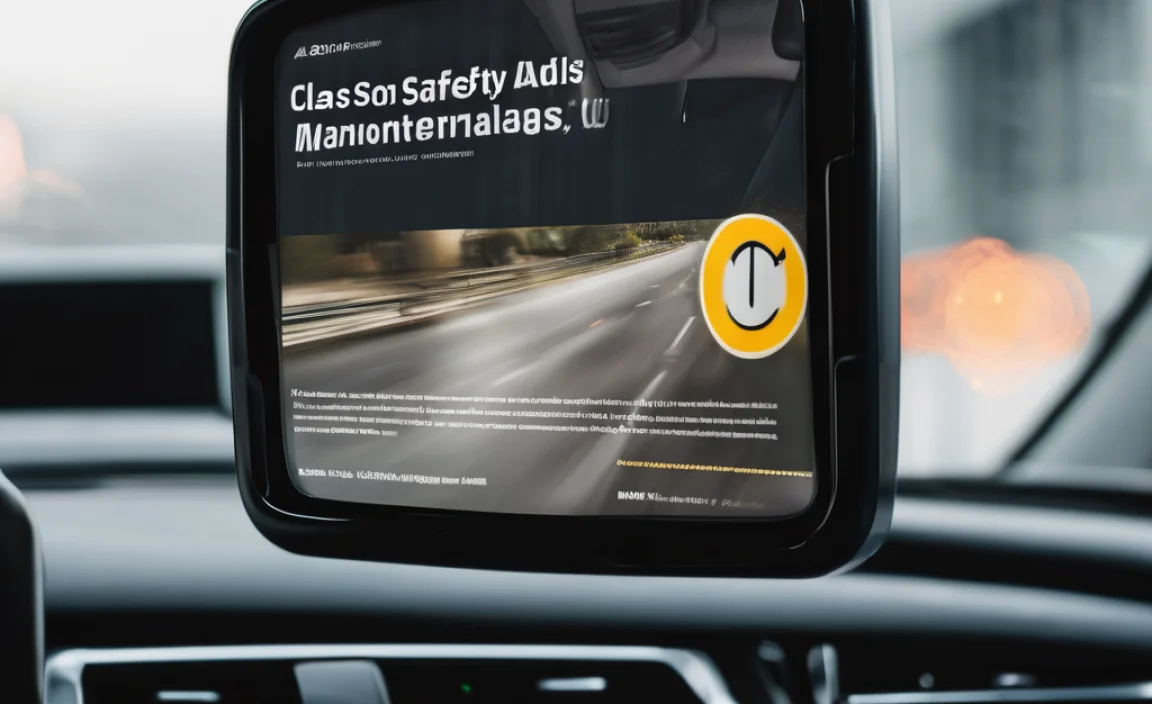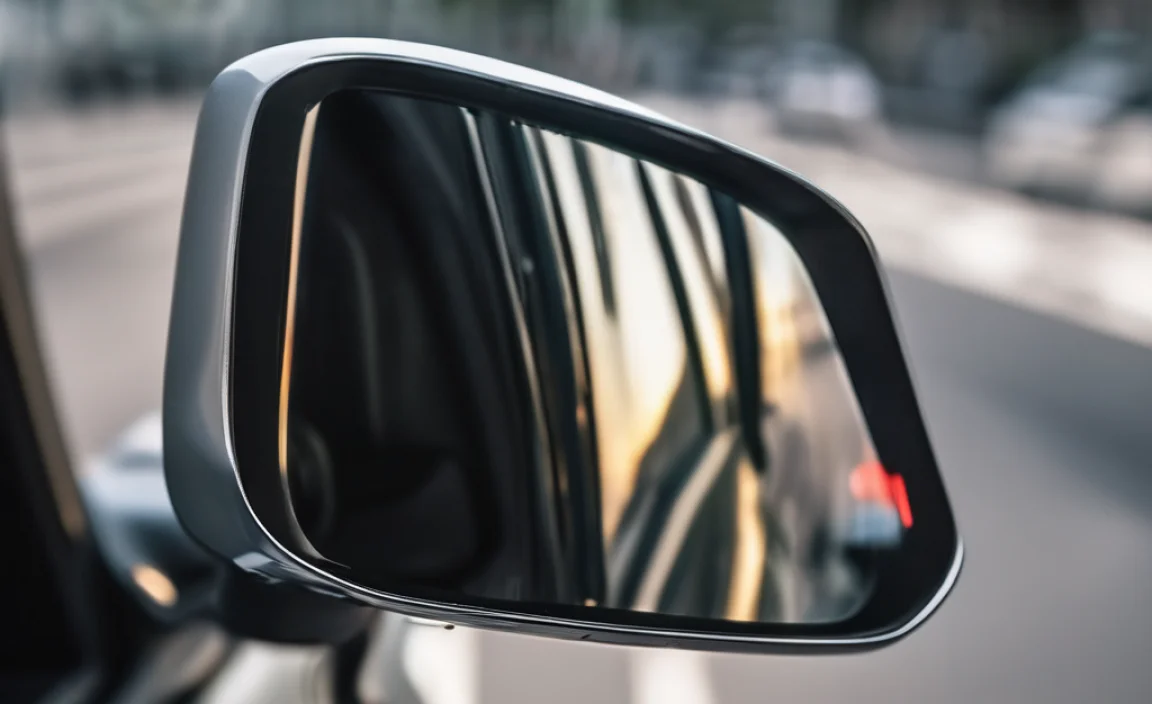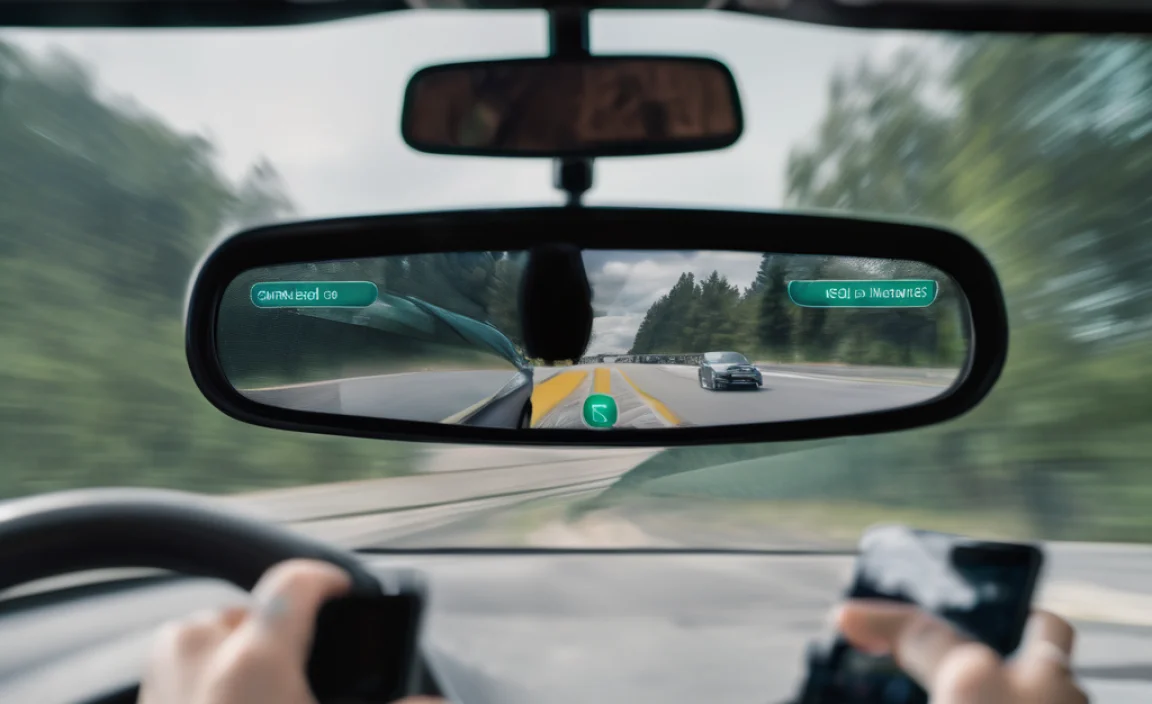The Mercedes-Benz GLA-Class blind spot monitor is a vital safety feature that significantly reduces the risk of accidents by alerting you to vehicles in your blind spots. Activating and understanding this system is straightforward and can be learned quickly, offering peace of mind on every drive.
Dealing with blind spots in any car can be a nerve-wracking experience, especially in busy city traffic or during highway lane changes. For Mercedes-Benz GLA-Class owners, this concern is easily addressed with the Blind Spot Assist system. This advanced technology acts as a helpful co-pilot, keeping an extra set of eyes on those tricky areas around your vehicle. You’ll be able to navigate changes with greater confidence and safety, knowing that a crucial warning system is at work.
This guide will walk you through everything you need to know about your GLA-Class blind spot monitor. We’ll explore how it works, how to activate or deactivate it, what the indicators mean, and why it’s such an incredible safety upgrade for your already luxurious and capable SUV. Get ready to feel more secure on the road!
Understanding Your GLA-Class’s Blind Spot Monitor

The Blind Spot Assist system in your Mercedes-Benz GLA-Class is designed to do one primary thing: prevent those dangerous moments when you might not see another vehicle when changing lanes. It uses sophisticated radar sensors, typically located in the rear bumper, to detect other vehicles in the areas around your car that your mirrors might miss. These are the “blind spots.”
When the system detects a vehicle in a blind spot, it provides a visual alert. If you then activate your turn signal while a vehicle is detected, it will also provide an audible warning, and often a more intense visual cue, to strongly advise against changing lanes. This layered approach is designed to catch your attention before a potentially hazardous situation can develop.
How Does Blind Spot Assist Work?
At its core, the system relies on radar sensors. These sensors emit radio waves that bounce off other objects, returning to the sensor. By analyzing how long it takes for the waves to return and the pattern of the reflection, the system can determine the presence, distance, and relative speed of other vehicles. Your GLA-Class typically has these sensors positioned discreetly within the rear bumper assembly.
The system is designed to be active within a certain speed range, usually above 12 mph (20 km/h). Below this speed, the detection capabilities might be limited, as the risks associated with blind spots are generally lower at very slow speeds. It continuously monitors the areas to the:
- Rear side, on the driver’s side
- Rear side, on the passenger’s side
It’s important to note that while highly effective, Blind Spot Assist is a driver-assistance system, not a substitute for attentive driving and proper mirror adjustments. Always perform your own visual checks before changing lanes, even with the system active.
What the Indicators Mean
Your GLA-Class will communicate the status of the Blind Spot Assist system through visual cues, usually integrated into your exterior mirrors. These are typically small, illuminated icons.
Here’s a breakdown of what you’ll commonly see:
- Solid Red Icon: This is the primary alert. A solid red icon, usually located on the inside of your side mirror glass, means that the system has detected a vehicle in your blind spot on that side. You should be extra cautious and avoid changing lanes until the icon disappears. For example, if a car is in your driver-side blind spot, the red icon will appear in your driver-side mirror.
- Flashing Red Icon: If you activate your turn signal while the solid red icon is illuminated, the indicator in that mirror will begin to flash red. This is a more insistent warning, signaling that it’s particularly unsafe to change lanes immediately because a vehicle is present in your blind spot. Your car might also provide an audible chime.
- No Icon / Icon Not Lit: This indicates that the system is active and currently not detecting any vehicles in your blind spots. It doesn’t mean the system is off; it simply means there’s no immediate hazard detected in the blind zones.
Activating and Deactivating Blind Spot Assist
Modern Mercedes-Benz vehicles offer convenient ways to manage your safety systems. For your GLA-Class, you can typically control Blind Spot Assist through the vehicle’s infotainment system or a dedicated button.
Using the MBUX Infotainment System (Common on newer GLA models):
- Turn on your vehicle (engine running or ignition in accessory mode).
- Navigate to the “Vehicle” menu on your MBUX display.
- Look for “Assistance” or “Driver Assistance.”
- Within this menu, you should find “Blind Spot Assist” or “Blind Spot Monitoring.”
- You will see options to turn the system ON or OFF.
Using a Dedicated Button:
Some GLA-Class models might have a physical button, often located on the dashboard or driver’s side door panel, that allows for quick access to driver assistance settings. This button may have an icon representing a car with lines indicating blind spots. Pressing this button can cycle through modes or directly turn the system on/off, often with a confirmation message on your instrument cluster.
Refer to your owner’s manual for the most precise instructions for your specific model year and trim. It’s a good idea to familiarize yourself with these settings so you can adjust them as needed.
Why Blind Spot Monitor is an Essential Safety Upgrade

The importance of blind spot monitoring cannot be overstated. It addresses a common and dangerous driving oversight, providing an extra layer of safety that can prevent serious accidents. Let’s delve into why this feature is so crucial.
Reducing Lane Change Accidents
The vast majority of lane change accidents occur because a driver simply didn’t see another vehicle in their blind spot. Even with carefully adjusted mirrors, certain areas around the car are inherently difficult to see. Blind Spot Assist acts as an electronic guardian, specifically designed to detect vehicles in these vulnerable areas and alert you before you make an unsafe maneuver.
According to the Insurance Institute for Highway Safety (IIHS), blind spot detection systems are estimated to reduce lane change crashes by 8% and increase the rate of lane changes without a crash by 28%. This is a significant impact on road safety.
Enhancing Driver Confidence
When you’re driving a vehicle as capable and commanding as a GLA-Class, you want to feel confident in every maneuver. Blind Spot Assist contributes significantly to this confidence, especially in challenging driving conditions like dense traffic, inclement weather, or at night when visibility is reduced. Knowing that the system is actively monitoring your surroundings can reduce driver stress and fatigue.
Compatibility with Various Driving Conditions
Blind Spot Assist is designed to work across a range of scenarios:
- Highway Driving: Essential for high-speed lane changes.
- City Traffic: Helps navigate the unpredictable nature of urban driving.
- Merging: Crucial when merging into faster-moving traffic.
- Adverse Weather: Radar sensors are less affected by rain or fog than human vision.
Technology Integration
Mercedes-Benz is renowned for its cutting-edge technology, and Blind Spot Assist is a prime example. It seamlessly integrates with other vehicle systems, offering a cohesive and intelligent safety package. The visual and audible alerts are designed to be noticeable without being overly intrusive, striking a balance between information and driver focus.
Getting the Most Out of Your GLA-Class Blind Spot Monitor

To ensure your Blind Spot Assist system is always operating at its best, there are a few practical considerations:
Regular Cleaning of Sensors
The radar sensors are typically located behind the rear bumper cover. While they are robust, they can be affected by dirt, mud, snow, or ice. If the sensors become significantly obstructed, the system may not function correctly and might display a warning message.
How to Clean (DIY Friendly):
- Identify Sensor Locations: Consult your owner’s manual to locate the approximate positions of the sensors on your rear bumper. They are usually small, flat areas.
- Gentle Washing: When washing your car, pay special attention to these areas. Use a soft cloth or sponge with car soap and water.
- Remove Stubborn Grime: If dirt is caked on, avoid harsh scraping. A plastic trim tool or a stiff nylon brush can be used gently, ensuring you don’t scratch the bumper. For ice, allow the vehicle to warm up or use a de-icer spray made for automotive use if necessary.
- Avoid High-Pressure Washing Directly: While car washes are generally fine, avoid directing a high-pressure washer directly at the bumper for extended periods, as this could potentially force water into sensor housings over time.
Understanding System Limitations
No technology is perfect, and it’s vital to understand the limitations of Blind Spot Assist:
- Not a Collision Prevention System: It warns you; it does not automatically brake or steer to avoid a collision.
- Detection Range: The system has a specific operational range. Very fast-approaching vehicles or those far away might not be detected immediately.
- Sensor Obstruction: As mentioned, dirt, snow, or heavy debris can impair sensor function.
- Stationary Objects: It’s primarily designed for moving vehicles, not stationary objects like guardrails or parked cars.
- Motorcycle Detection: While many systems are improving, smaller vehicles like motorcycles can sometimes be more challenging to detect consistently than larger cars and trucks.
Proper Mirror Adjustment
Even with Blind Spot Assist, correct mirror adjustment is crucial. A well-adjusted side mirror should show a sliver of your car’s side panel. This allows you to see your blind spot alongside the visual confirmation from the system.
Quick Mirror Adjustment Tip:
- Driver’s Side Mirror: Adjust so you can just barely see the right edge of your car.
- Passenger’s Side Mirror: Adjust so you can just barely see the left edge of your car.
This setup minimizes overlap between your mirrors and your peripheral vision, effectively reducing your blind spots.
When to Consider an Upgrade (if not standard)
While many newer GLA-Class models come standard with Blind Spot Assist, some earlier models or specific trims might have offered it as an optional upgrade. If your GLA-Class doesn’t have it, consider it a valuable addition. Retrofitting can be complex and costly, often involving new mirror housings, bumper components, wiring harnesses, and complex programming. However, for a significant safety improvement, it’s an option worth exploring with a qualified Mercedes-Benz specialist or dealership.
Blind Spot Monitor vs. Other Driver Assistance Features

Your GLA-Class likely boasts a suite of advanced driver assistance systems (ADAS). It’s helpful to understand how Blind Spot Assist complements these other features.
Here’s a comparison:
| Feature Name | Primary Function | How it Works | Blind Spot Monitor’s Role Relative to This |
|---|---|---|---|
| Blind Spot Assist | Detects vehicles in blind spots and warns driver. | Radar sensors in rear bumper, visual/audible alerts. | Focuses on lateral detection to the rear, prior to or during lane changes. |
| Lane Keeping Assist | Helps keep the vehicle within its lane. | Cameras detect lane markings, minor steering corrections applied. | Blind Spot Assist warns if it’s unsafe to leave the lane; Lane Keeping Assist helps you stay in it. |
| Active Cruise Control (Distronic) | Maintains a set speed and distance from the vehicle ahead. | Radar and camera sensors monitor distance and speed. | While Distronic manages front distance, Blind Spot Assist manages lateral space for lane changes. |
| Rear Cross-Traffic Alert | Warns of approaching vehicles when reversing. | Radar sensors in the rear bumper. | Blind Spot Assist works when moving forward; Rear Cross-Traffic Alert works in reverse by detecting vehicles approaching from the sides. |
| Parking Sensors / Surround View | Detect obstacles during parking and low-speed maneuvers. | Ultrasonic sensors and cameras around the vehicle. | Different focus: Parking aids are for stationary objects at very low speeds; Blind Spot Assist for moving vehicles at higher speeds. |
Think of these systems as a team. Blind Spot Assist is your dedicated lookout for overt vehicular threats from the sides. Other systems handle different aspects of driving, all working together to make your journey safer and less stressful.
Frequently Asked Questions (FAQ)
Q1: How do I know if my GLA-Class has Blind Spot Assist?
Answer: The easiest way is to look for small, illuminated icons on the inside edge of your exterior side mirrors. These icons are typically red when a vehicle is detected in the blind spot. Many GLA models also display system status messages on the instrument cluster. If you’re unsure, consult your owner’s manual or contact a Mercedes-Benz dealership.
Q2: Can I turn off Blind Spot Assist?
Answer: Yes, you can typically turn Blind Spot Assist on or off via the vehicle’s MBUX infotainment system under the ‘Assistance’ or ‘Driver Assistance’ menu. Some models might have a dedicated button. It’s recommended to keep it on for maximum safety.
Q3: What should I do if my Blind Spot Assist warning light is on?
Answer: If the red light is solid, it means a vehicle is detected in your blind spot. Do not change lanes until the light turns off. If you activate your turn signal with the light on, it will flash and may make a sound, indicating it is particularly unsafe to proceed with the lane change.
Q4: Does Blind Spot Assist work in all weather conditions?
Answer: Blind Spot Assist uses radar sensors which are generally less affected by rain, fog, or snow than camera-based systems would be. However, extremely heavy buildup of snow, mud, or ice on the sensors can hinder their performance. Always ensure the sensors on your rear bumper are clean.
Q5: Can Blind Spot Assist detect motorcycles?
Answer: Most modern Blind Spot Assist systems are designed to detect vehicles of various sizes, including motorcycles. However, due to their smaller profile, they might sometimes be harder to detect than larger vehicles, especially at longer ranges. Always perform your own visual checks.
Q6: My Blind Spot Assist is not working or shows a warning light. What should I do?
Answer: First, check if the sensors on your rear bumper are clean. If they are clean and the system is still not working or displaying a warning, there might be a malfunction. You may need to consult your owner’s manual for specific troubleshooting steps or contact a Mercedes-Benz service center for diagnosis and repair.
Q7: Is Blind Spot Assist the same as Lane Change Assist?
Answer: While related, they are not exactly the same. Blind Spot Assist monitors for vehicles in your blind spots. Lane Change Assist, often part of more advanced systems, might actively intervene or provide stronger warnings if you attempt to change lanes unsafely while a vehicle is detected. However, in Mercedes-Benz terminology, “Blind Spot Assist” often encompasses the warnings related to lane changes.
Conclusion
The Blind Spot Monitor is more than just a fancy gadget; it’s a fundamental safety enhancement for your Mercedes-Benz GLA-Class. By diligently alerting you to unseen vehicles, it dramatically reduces the risk of dangerous collisions during lane changes and merges, turning potentially hazardous situations into smooth, confident maneuvers.
Understanding how the system works, what its indicators mean, and how to keep it functioning optimally – by ensuring clean sensors and proper mirror use – empowers you as a driver. It allows you to leverage this intelligent technology to its fullest potential, adding a significant layer of security for yourself, your passengers, and everyone else on the road. Embrace this essential feature, and enjoy every drive in your GLA-Class with enhanced peace of mind.